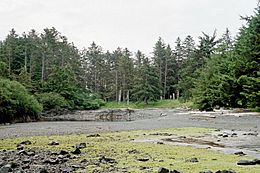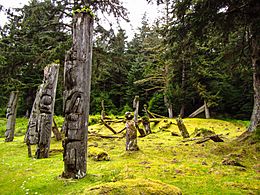Ninstints facts for kids
Quick facts for kids S'G̱ang Gwaay Llanagaay |
|
|---|---|
| Ninstints | |

Haida village of S'G̱ang Gwaay Llanagaay
|
|
| Location | Haida Gwaii, North Coast of British Columbia, Canada |
| Official name: Nan Sdins National Historic Site of Canada | |
| Designated | 1981 |
| Official name: SG̱ang Gwaay | |
| Type | Cultural |
| Criteria | iii |
| Designated | 1981 (5th session) |
| Reference no. | 157 |
| State Party | Canada |
| Region | Europe and North America |
| Lua error in Module:Location_map at line 420: attempt to index field 'wikibase' (a nil value). | |
SG̱ang Gwaay Llanagaay ("Red Cod Island"), also known as Ninstints, is an old village site of the Haida First Nation. It is located on Haida Gwaii, a group of islands off the coast of British Columbia, Canada. This special place is part of the Gwaii Haanas National Park Reserve and Haida Heritage Site.
This village is very important! It is recognized as a UNESCO World Heritage Site, a National Historic Site of Canada, and a National Marine Conservation site.
Contents
What's in a Name?
The Haida name for the village, SG̱ang Gwaay llnagaay, means "Red Cod Island." This is because the village is located on Anthony Island.
Long ago, in the late 1700s and early 1800s, the village was sometimes called Koyahs or Coyahs. This name came from the chief who led the village at that time, Koyah.
The name "Ninstints" (or "Nan Sdins") became popular later. It was the name of a powerful chief in the mid-1800s. Ship captains often called villages by the name of their leader. This is how "Ninstints" became the common name for the village.
Exploring the Village Site
SG̱ang Gwaay llnagaay was the southernmost Haida village. It sits in a calm bay on the east side of Anthony Island. This spot is very private and protected. It is one of the earliest recorded villages in the southern part of the Haida Gwaii islands.
Today, SG̱ang Gwaay llnagaay has the largest collection of totem poles still standing in their original spots. Many of these poles are seen as amazing works of art. Even though they are slowly decaying due to the wet, temperate rainforest climate, they are still a powerful sight. Pictures of these totem poles are famous symbols of Haida culture and Haida Gwaii. They are often used to promote tourism for the islands and the province.
Getting to the site is quite an adventure because it's very remote. You can only reach it by boat or plane from towns in the northern part of the islands. To keep these valuable Haida heritage sites safe, the Haida people have a special program called the Watchmen. Haida Watchmen live at traditional village sites, including those within Gwaii Haanas National Park Reserve and Haida Heritage Site. They make sure visitors act respectfully and help protect their traditional lands.
A Look at History
Archaeologists have found proof that people have lived on Haida Gwaii for thousands of years. The Haida people's lands once stretched north into Alaska.
The people who lived at SG̱ang Gwaay llnagaay are sometimes called the Kunghit Haida. They lived in the southern part of the Haida Gwaii islands. Their territory went from Lyell Island all the way to the southern tip of the archipelago. They had about two dozen permanent villages. They also had smaller seasonal camps near important places for resources. Early records say there were about twenty longhouses in the village.
Larger Kunghit Haida villages could have twelve or more longhouses. Each longhouse might have housed thirty to forty people. Village populations could range from less than two hundred to more than five hundred people. One of the chiefs from the Ninstints family, named Thomas Price, was a very skilled artist. He was known for carving beautiful Haida art, especially from a special black stone called argillite.
European Contact and Changes
SG̱ang Gwaay Llanagaay was important in the early days when Europeans first arrived and started trading with the Haida. In 1787, a man named George Dixon visited the village. He noticed that the Haida people were eager to trade sea otter furs. At first, the trade relations were friendly.
Other explorers visited too, like Charles Duncan in 1788. Then, in 1789, Robert Gray and John Kendrick visited. During Kendrick's visit, the trading relationship became less friendly.
In the years that followed, trade between the Haida and European traders got better. Because of this, many Haida people moved to bigger towns like Masset, Skidegate, and even Victoria. They wanted to take advantage of the growing trade.
For those who stayed at SG̱ang Gwaay Llanagaay, their population dropped a lot because of the 1862 Pacific Northwest smallpox epidemic. In the years after, more people died from other diseases brought by outsiders. Around 1885, the remaining people from SG̱ang Gwaay Llanagaay moved to Skidegate. By 1875, the old village site was mostly used as a temporary camp.
See also
 In Spanish: Ninstints para niños
In Spanish: Ninstints para niños


